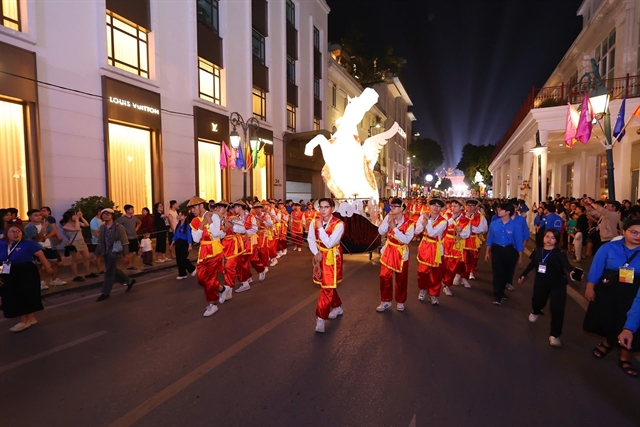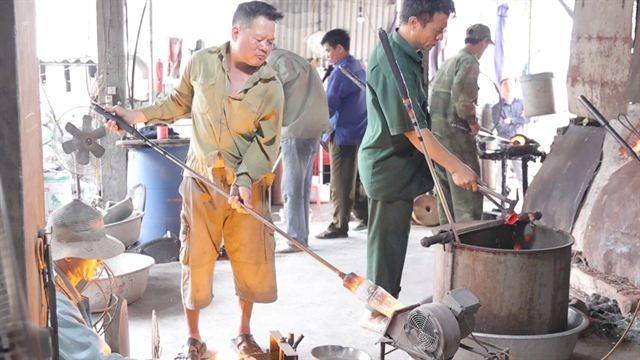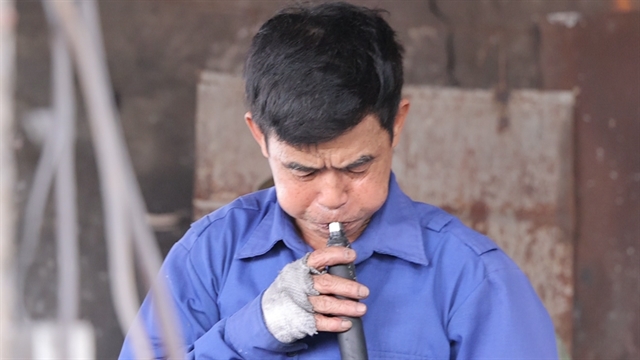 Sunday/Weekend
Sunday/Weekend

By Anh Ngô
(Additional reporting by Lê Hương)
Those who have enjoyed Hà Nội's famed draught beer will find it hard to forget the popular blueish glasses with air bubbles that are something of a symbol of the capital's street side drinking holes.
The beer glasses are almost exactly the same everywhere across the city, and they are mostly made in the same village just two hours by car from the capital centre.
These rustic glasses are made by skilled craftsmen in Xối Trì Village, in the northern province of Nam Định where people have been blowing glass for 70 years.
Glassblowing village
Village residents pursue glassblowing to create glasses mainly used for beer drinking by recycling shards of glassware with rudimentary tools and techniques handed down from generations past.
“I have been working for 40 years. We do everything manually. This is a traditional craft passed down from father to son. My father and uncle learned this craft in Hải Phòng when they were young, about 17 years old, and later passed it on to their children and grandchildren,” glassblower Đỗ Phước Tiến, 65, told Việt Nam News.
“Nowadays, we can produce over 2,000 glasses a day from recycling shards of glassware."
 |
| Residents of Xối Trì Village continue to use the ancient craft of glass blowing to create beer glasses. VNS Photo Anh Ngô. |
Creating a glass is a multi-step process. The pieces of broken glassware are meticulously sorted by colour such as blue and white and need to be guaranteed not to stain.
“My daily tasks involve packing glasses in the morning and classifying in the afternoon. The job can be dangerous at times. Sometimes tiny glass pieces may fly into our eyes, but we have got used to it and can avoid accidents,” said worker Phạm Thị Nhuần, 65.
“The materials for making beer glasses include broken glass pieces, which are collected from various glassmaking facilities or bought from scrap dealers,” she added.
The glass shards are then melted in the furnace with a temperature exceeding 1,800 degrees Celsius for about 6 hours until they become a liquid for blowing.
The glass-blowing technique plays a crucial role in creating the capital's iconic beer glasses. Glassblowers use a metal pipe to collect the molten glass. They roll the glass on a flat surface lubricated with some grease to ensure smoothness and shine before blowing it into pre-existing moulds.
The craftsmen must regulate their breathing to ensure it is smooth and suitable to achieve the desired shape.
“The work requires skill and repetition to master it. I am already accustomed to the blowing technique for glass cups. If someone unfamiliar blows, their breath won't be even, causing it to bulge improperly,” Tiến said.
 |
| The blowing technique is the most important in the glass shaping steps. VNS Photo Anh Ngô. |
To ensure continuous production, the glass cup production line includes five blowers shaping the cups, one worker trimming the cup's mouth, and another handling the cooling process. At the final stage, the hot cups are buried under a pile of ash to cool slowly; if the glasses cool too fast, they will shatter.
Keeping the flame alive
1985-1995 was considered a heyday for the glass trade at Xối Trì when 85 per cent of villagers engaged in it. However, the golden time has gradually passed.
“This village used to have 13-15 facilities, but now only three remain. Sourcing raw materials is getting more and more difficult. We have to buy materials quickly before other buyers. That is why many other workshop owners have got fed up with the business,” said worker Phạm Ngọc Hinh, 69. “Chinese products have flooded the market. Products from factories in Thái Bình have also flowed in, saturating the market.”
The villagers' only option to preserve their craftsmanship is to produce these rough-looking beer glasses for orders from Hà Nội.
 |
| Craftsmen must regulate their breathing to ensure it is smooth and suitable to achieve the products with the desired shape. VNS Photo Anh Ngô. |
“Now we are trying to maintain production and hope some investors will support us and invest in machinery,” Hinh said. “It will help make it less strenuous for workers to engage for longer, otherwise hardship may eventually lead them to quit.”
 |
| CHEERS: Beer glasses in capital are almost all exactly the same. VNS Photo Seán Nolan |
Each day, these glasses are shipped to Hà Nội, the bustling capital, where glugging fresh beer has become a die-hard habit for many. These glasses are the motivation for the Xối Trì craftsmen to keep their tradition alive, stick to their jobs, and make ends meet. — VNS




